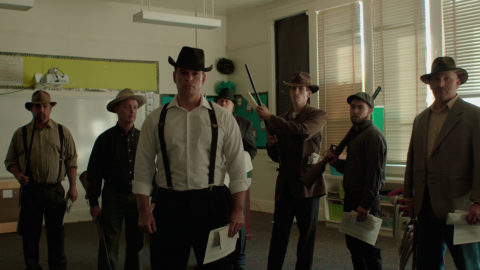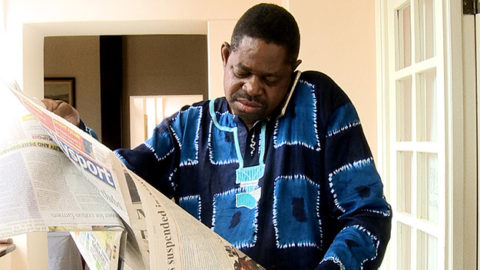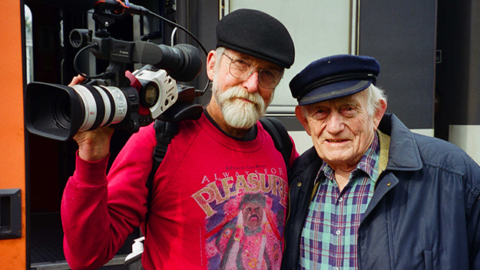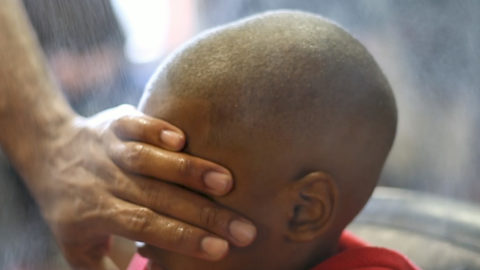
Make It Real: Shots Heard Round the World
Open on motion. Moving from right to left past a blurry, jittery landscape—maybe looking out from a car, maybe filmed on the run, possibly seen through a zoom lens, apparently captured on film yet projected digitally, definitely abstracted. There’s green, likely greenery, in the distance, and yellow, likely tall yellow grass, in the foreground, and in between there’s a lattice-like interference: dark, warping verticals impeding here from there. For three straight minutes it goes on like this—a sweep of cubistic kaleidoscopic motion leavened by a creeping sense of blockage, of imprisonment.
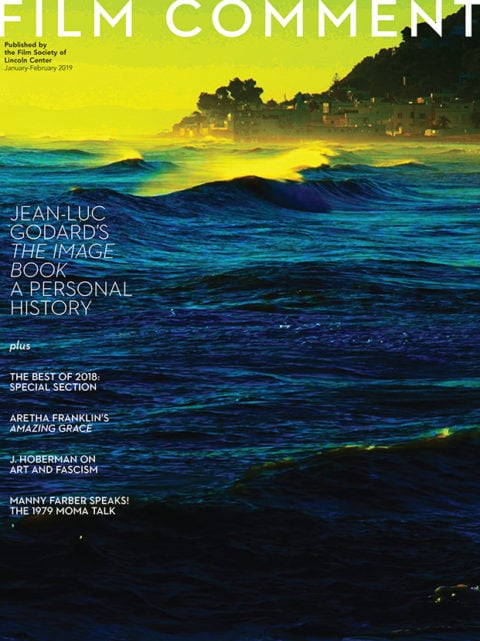
These are the first images in Joshua Bonnetta’s and J.P. Sniadecki’s El mar la mar, and many months later I’ve not been able to shake them. The sequence is tremendously arresting as cinematography, but it’s not only that. It lingers also because it’s a compact, oblique synecdoche for the whole film, the opening salvo of a rigorous rumination on the experiences of migration along the U.S./Mexico border. The viewer doesn’t necessarily know this, especially since it comes at the top of the film, but he or she might sense something forming, and keep the shots in mind—or at the ready, like a magnifying lens through which to consider the rest of the film—before bringing them forth when it’s all done, like the most vivid remembrance of a dream. There were a number of such moments—instances of bravura filmmaking, encapsulation, metaphorical resonance—that I carried around with me this year.
Cut to a young man pushing open a door to join us outside, before turning to our left. While walking past several storefronts (“VaVoom! Vintage”) and a sign for a “Muheim Heritage House Museum,” he puts on an old style hat, the camera swinging behind him to absorb the direct sunlight, along with the movement of minivans in a contemporary American town. He takes off his denim jacket and hoodie, revealing suspenders crossed against a wide-necked cotton shirt, then puts on a dark jacket, and suddenly he’s costumed. He walks into another door, passes signs for “Bisbee Realty Co.”—still we’re tracking with him, behind and beside—passes desks and fluorescent lights affixed to dropped ceilings and then somehow crosses into another space in the same building, a C.S. Lewis–like wardrobe portal into a different, if adjacent dimension, where glowing bulbs alight a tall, airy, dusty space. We’re in an abandoned theater, and now we’re ahead of the young man, guiding him to the front of the room. The camera finally holds on the stage, to which the young man ascends and declares: “My name is Fernando Serrano. I’ll be playing a miner in the Bisbee Deportation.” Fifteen minutes into Robert Greene’s the-past-is-present pageant Bisbee ’17, in which current citizens of an Arizona mining town play progenitors from a shameful moment in 1917, DP Jarred Alterman’s two-and-a-half-minute-long Steadicam shot winds, wraps, and laces into a tight ball everything that the rest of the film is unwinding and teasing out. No edits, no seams, no distinction made between then and now, personal style or costume, reality or magic.
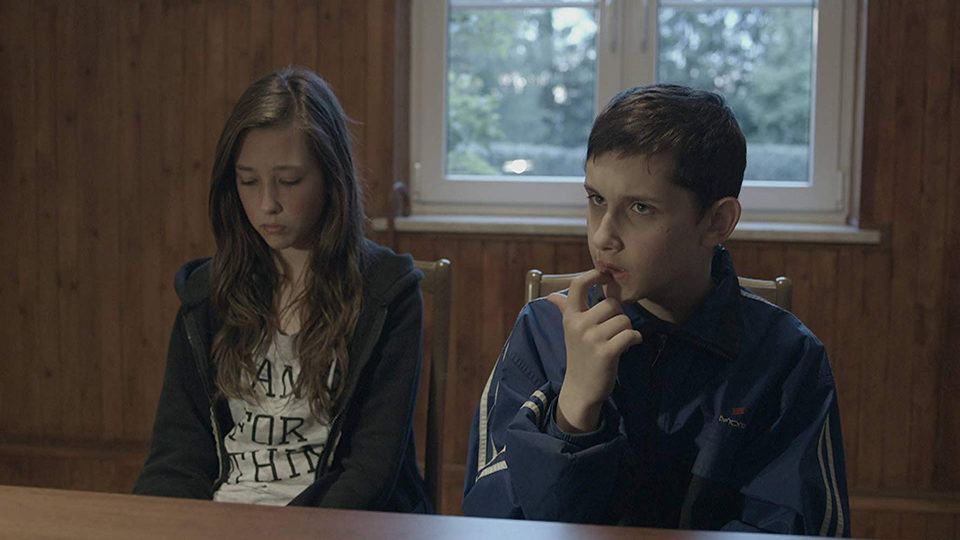
Communion
Hold on a two-shot of a sister and brother. Nikodem is taking questions from an off-screen instructor for an oral examination to make Catholic communion in Anna Zamecka’s Polish family portrait Communion. He’s acing the test while fighting back autistic spasms and with the support of his sister, Ola, who’s coaching him and subtly cajoling patience from the instructor, continuing to handle him more like a mother, or guardian, than a sibling (mom doesn’t live with them, and dad is often absent). Cut to Ola in profile, smiling and talking to her friends as a song begins to echo around a school dance hall. Cut to boys, early teen boys, awkwardly gathering on the opposite side of the room. Cut back to Ola, now climbing atop a bench along the wall to join two friends, raising her hands in the air and full-body singing along with Christina Aguilera: “Whoah-oh-oh-oh, I just want to feel this moment.” Liftoff to an interplay between the boys dancing off against the girls on the opposite side, which concludes with Ola flush with excitement and demanding “a rematch.” Hard cut to Ola, no longer with her friends but still in the yellow dress she wore to the dance, storming into the apartment where she lives, crying and kicking things out of her way, shouting over Nikodem, “You call this a home? It’s a pigsty.” It’s a sequence as long and lyrical and impeccable as a pop song, and contains a novel’s worth of characterization.
There’s an uncommon patience to Distant Constellation, in which director Shevaun Mizrahi installs us in an old folks’ home in Istanbul. It’s not that the film demands endurance, as with a work of slow cinema, but rather that Mizrahi has done the work of sitting with and paying attention to, on a minute level, those she films. She adapts to their pace, making the material itself extraordinarily attentive. Nowhere is this more evident than in a sequence midway through the film in which a very elderly woman who calls herself Selma opens up about never having children or being able to afford marriage in the impoverished wake of the Armenian genocide. She advises the unseen Mizrahi to get married while she can, then recalls a beloved child for whom she worked as a nanny. Throughout, her head is bowed, and she strains to deliver every word—in English. Mizrahi doesn’t cut. She doesn’t shape the sequence to hustle us to the point. Listening is the point. Just listening to Selma is a holy act. Then, mid-thought, she falls asleep. The camera keeps rolling, waiting. Her slow, calm breathing is beautiful. It’s worth the wait. Eventually she wakes. “I’m sorry,” she says, grinning a bit, eyes still closed. “I drop like that.”
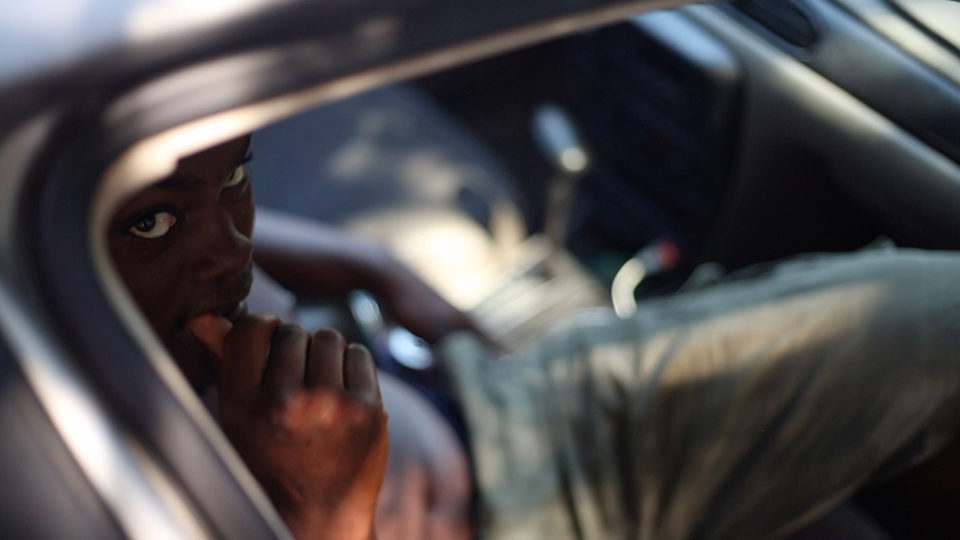
Hale County This Morning, This Evening
And finally, every image in Hale County This Morning, This Evening has stuck with me this year, vivid and unresolved. None of the entry or exit points of the shots, none of the sequencing, feels familiar or expected. It’s all continuously active, still mysterious and new. The film is constructed around the loosest of narratives, in which director RaMell Ross follows Daniel Collins and Quincy Bryant over the course of five years in their largely African-American home community of Hale County, Alabama. It’s a film that doesn’t just employ and deploy images, it interrogates and reflects upon them—its own and their usage, the audience’s potential assumptions regarding them, and also implicitly the depictions and framings you’d more commonly find elsewhere. This intensely complex but also thoroughly pleasurable process of really looking starts from the first shot. A young man exits the back seat of a car and glares back at the camera. Yet we hold on him past the completion of this brusque gesture to capture another, much softer expression, in which he casts back at the camera, and unconsciously to his potential future judges in the audience, conveying something like, “are you coming?” or “are you still filming?” Ross does keep filming, and frequently lets us witness that, most memorably for two consecutive unbroken shots, each several minutes in length. A tiny boy, newly confident on his legs, dashes back and forth and down the hall, over and over again, winded but tireless, outlasting every possible easy conclusion we’re tempted to draw about the purpose and meaning of the shot. Cut to a locker room before a college basketball game, where men much bigger but no less energetic dribble and cajole and roughhouse with one another. The shot keeps going, again long past what might have been quantified as a “scene,” with whatever exchange between the boys might have been used to construct a narrative. Meanwhile, as we’ve been waiting for Ross to show us something, we’ve been looking. We’ve been noticing things we might not have otherwise. The ease. The familiarity. The affection. The kid with his headphones on, lost in his own thoughts. The flickers of emotion, ambiguous and private, sparked from errant moments of play. Gradually, there’s so much to see.
Eventually that shot ends, too soon when it does. But we know there was more, we know that there is more. Being led to feel that way about every image in Hale County suggested I do the same in other movies as well. Especially in nonfiction, every choice can, and probably should, vibrate with every other possibility. The frame doesn’t contain, it demands that we look beyond it.
Eric Hynes is a journalist and critic, and curator of film at Museum of the Moving Image in New York.



